A year after activists pulled off an inspiring demonstration of what 3rd Avenue could look like, the Bureau of Transportation followed up with their permanent version.
The project comes with strong support from business interests (something almost as rare as new downtown bike lanes themselves) and the Old Town Chinatown Community Association. While it’s not the physically protected bikeways activists want (and Portland needs), the project represents a significant re-allocation of downtown real estate away from auto use and toward bicycle use. This new bike lane is the latest change in an area that is slowly but surely evolving into a much more human-centric place: Along with newly painted crosswalks on 3rd and 4th on both sides of Burnside, there are serious talks of a new plaza outside of Voodoo Doughnut on SW Ankeny, and the City of Portland is currently planning how best to spend over $6 million dollars to improve bicycling downtown.
I rode and walked the entire length of the new bikeway this morning. Here are my photos and thoughts…
At NW Glisan it’s a standard, six-foot bike lane with no buffers. There’s a parking lane on the right and two standard lanes to the left…
No buffer space means you’re this close to cars…
Advertisement
At NW Davis (home of the raining crosswalk), the buffer begins. There’s a two-foot buffer on the left and a three-foot buffer on the right.
This buffered lane lasts until just north of Burnside where PBOT has installed a new “mixing zone” where the bike-only lane disappears and is replaced with sharrows and right-turn arrows…
One of the well-known issues (happens on N Williams too) with these unprotected and uncolored bicycle lanes is that they are often confused for standard lanes…
Here’s a shot of some mixing going on…
Across Burnside the buffer continues and is accentuated with green near Voodoo Doughnut…
Looking back north from Ash toward Burnside…
Here’s how it looks outside of Stumptown Coffee between Ash and Pine…
Unfortunately, the new bike lanes end abruptly at SW Stark. Makes me wonder how this woman’s feeling about cycling will change from this block to the next…
PBOT has also added two new left-turn boxes at Burnside and Oak for people approaching the new bike lane from the east. These boxes help direct people onto the new bike lane. Here’s how one of them looks if you approach the new bike lane from SW Oak:
This project has evoked a mix of reactions from the community. People involved in the project are ecstatic to see such a significant redesign of a downtown street — especially since the changes came as a direct response to a grassroots demonstration. However, some people are disappointed that the project doesn’t include some form of physical separation and that it doesn’t transform the street like Better Block’s demonstration did last year.
I can understand both perspectives. Speaking of which, perspective is everything. I was struck by how different this bike lane looked and felt south of Burnside depending on which side of the street I stood on. 12-feet of dedicated bike lane sounds wonderful; but it’s really nothing compared to the vast expanse of roadways space we allow driving and auto parking on.
Here’s how the new bike lane looks from the east side of 3rd at Burnside. Compare the images below to the ones above…
And from the west side of 3rd at Ash the new bike lane drops at intersections, making it feel even less like the oasis of safety it should be…
The street outside Voodoo Doughnut is full of people and there’s a very clear demand for a public plaza and safer ways to cross. PBOT has recently painted new crosswalks on SW 3rd and 4th. This is great progress, but it has induced even more demand for even better walkways and bikeways…
It’s also worth noting that north of Burnside, people using this new bikeway face three different riding environments over the course of just a few blocks. As you can see in the image below, first there’s a bike lane without a buffer (background), than a buffered bike lane (middleground), then a mixing zone (foreground). Seems to me that a more consistent environment would be much lower-stress and would encourage more people to ride…
That thought raises the question: Will these new lanes inspire people to give biking a try? They do open up a nice connection to the green bike lane on SW Oak and the network effect will be even stronger once we build more bike lanes downtown.
What do you think?
— Jonathan Maus
jonathan@bikeportland.org
(503) 706-8804
@BikePortland


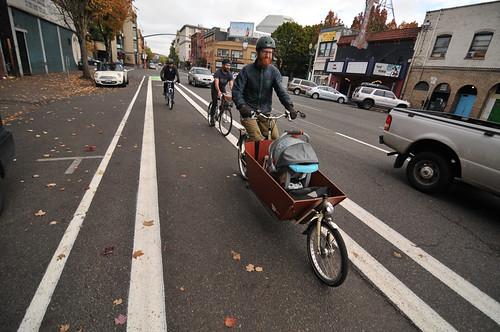
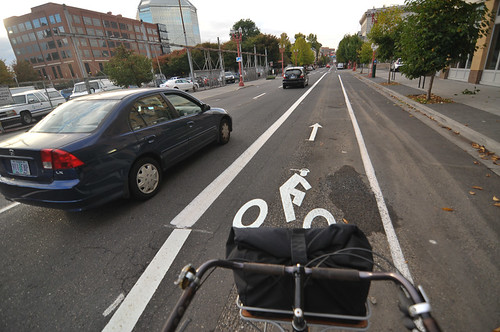
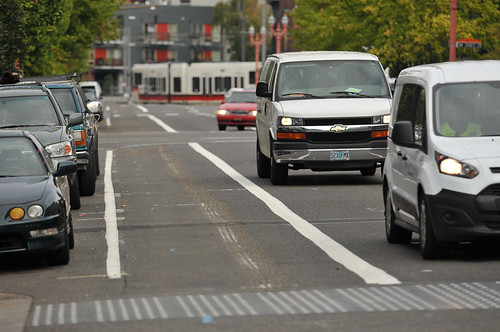
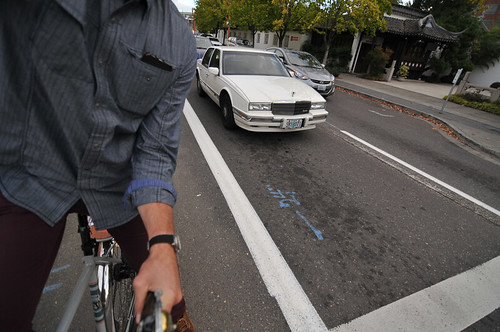
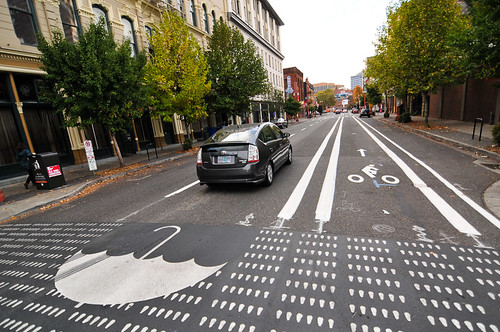
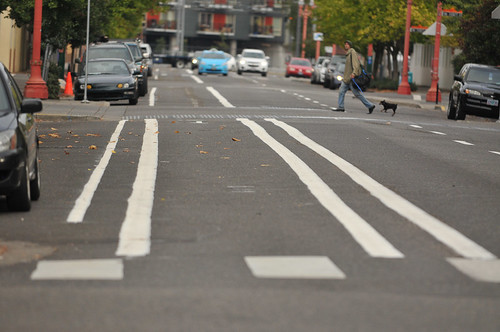
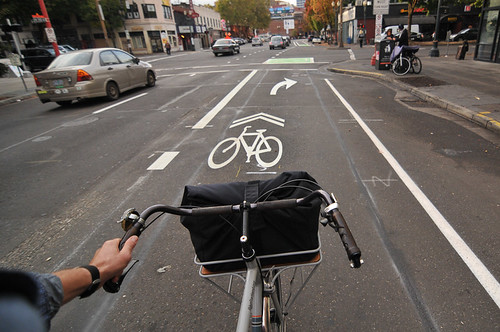

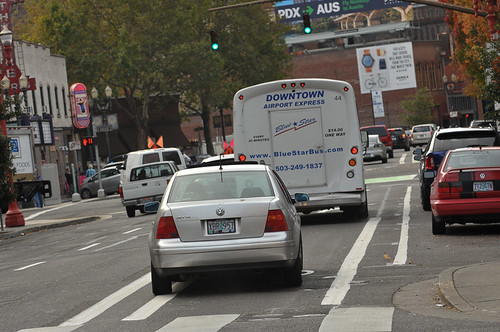
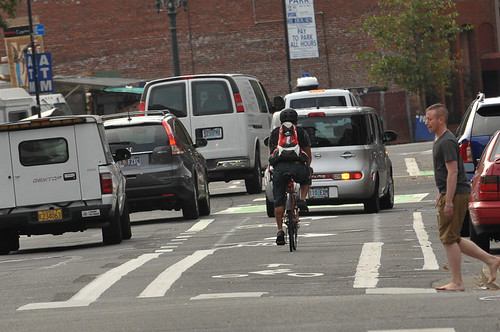

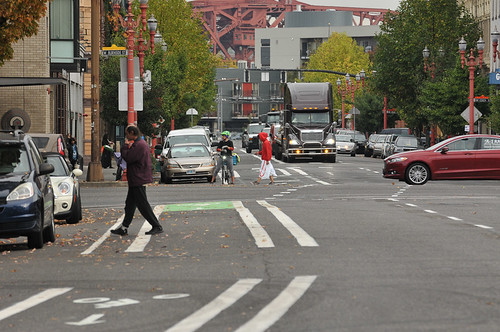
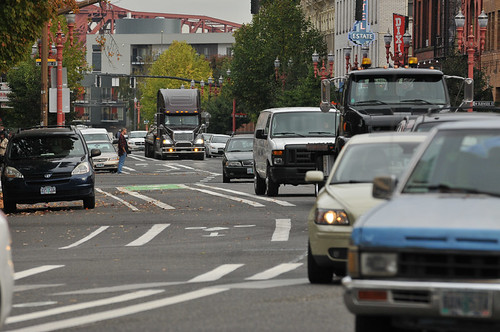

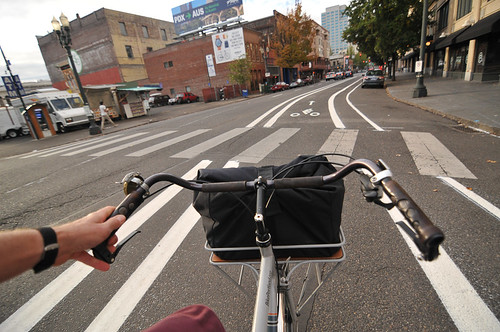


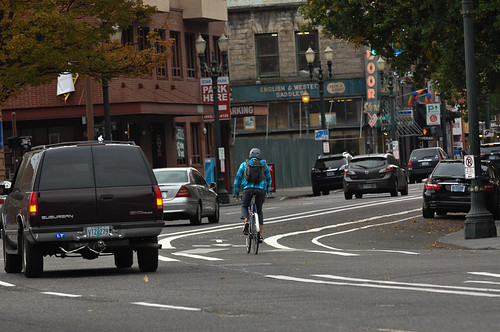

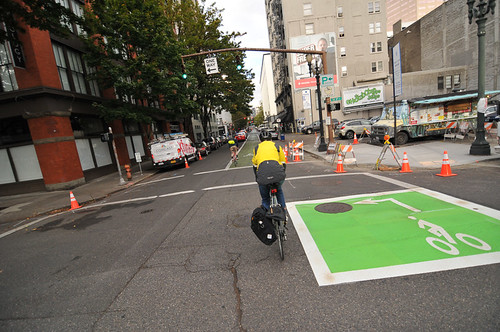

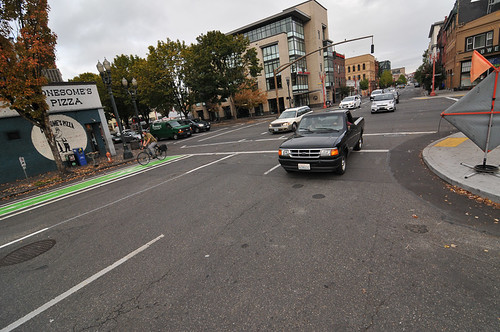
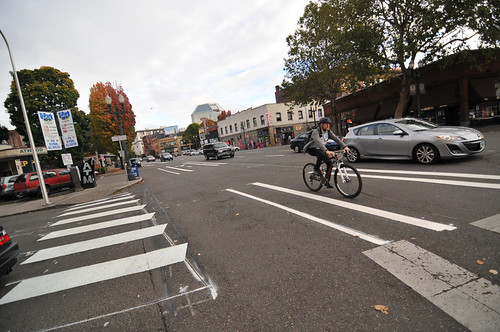

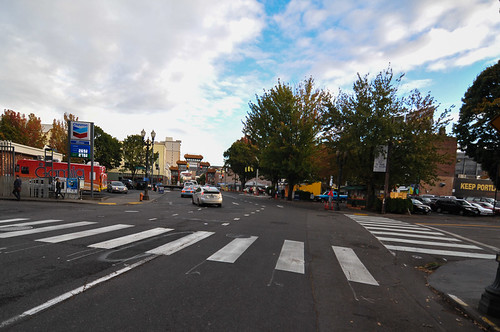
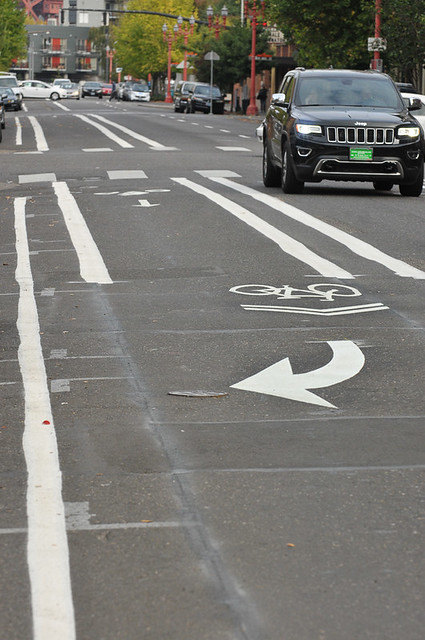

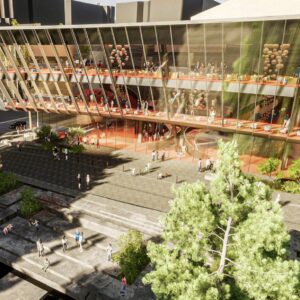

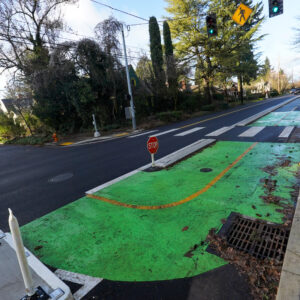
Thanks for reading.
BikePortland has served this community with independent community journalism since 2005. We rely on subscriptions from readers like you to survive. Your financial support is vital in keeping this valuable resource alive and well.
Please subscribe today to strengthen and expand our work.
Why are we still building bike lanes with mixing zones? PBOT is installing bike lanes with built-in conflict. When the bike lane suddenly disappears at the most dangerous point (the intersection) it undermines the entire thing. The bike lane is only as good as its weakest point.
This bike lane should have been a protected one from the start. I’m skeptical that this will attract new riders that previously did not ride. Plus, it connects to nothing from the north, so it’s not even that useful to people who do already ride.
PBOT, you need to try much harder if you want to end traffic violence and reduce car dependency.
Mixing zones are safer than right-hook bike lanes. I’m not aware of anyone in Portland dying in a mixing zone, but several have died from right-hooks.
I think the only way to eliminate conflicts at intersections with separated bike lanes is by using the “Dutch intersection” configuration: https://www.youtube.com/watch?v=FlApbxLz6pA See 1:06. Basically, for those cycling straight, the path curves slightly around the corner of the perpendicular street before allowing one to cross, and that way, any cars turning right will be facing you at a 90 degree angle.
It would be pretty damn expensive for us to build these everywhere though, although possible less so than a MAX line. Still, I don’t see Portland willing to invest what is necessary to do these properly anytime soon, which is why I think we should stick with what we are good at, namely bike boulevards, neighborhood greenways, or whatever you want to call them. Those are pretty cheap and don’t require a number of highly specific components to work well
can you point out the low-traffic road where we could build a greenway downtown?
Car-Free Park Blocks.
Yes, 5th and 6th would be good candidates, as would Park.
the park blocks are nowhere near this area. imo, 5th and 6th are the exact opposite of low stress streets. i personally feel safer splitting traffic on 4th than i do riding down 6th.
I suggested 5th and 6th because they only have one lane for cars each, and aren’t that great to even drive on. If the city put in a diverter every couple of blocks, they could eliminate most of the cars, and it would become a pretty nice street to bike on.
having to make low-visibility right turns across a large amount of bus and light rail traffic to get to the bridges makes 6th a ridiculous place for a bike facility, imo.
Funny story: there used to be diverters on the bus mall every few blocks, but they were removed in 2009 after the addition of the MAX tracks.
Cars should be banned on 5th and 6th, but those streets should not be the primary bikeway though downtown. The buses make sight lines difficult; plus they are loud, and spew exhaust. But the main reason is that you wouldn’t be able to turn right anywhere.
I agree that making a right turn off of 6th would be difficult if one were to try to merge to the right, crossing over the bus lane and the max tracks. However, if the city designed a way for bikes in the left lane to more easily make the right turn, then 5th and 6th with diverters every couple blocks could be a great option. Two ways to accomplish this would be 1) Allocate space for turning bays so that bikes could make a “Copenhagen right.” 2) Give bikes there own signal phase, similar to the bike light leading up from the East Bank Esplanade near the Moda Center, stopping the buses and max so bikes could make the right.
Maybe there’s another creative way for making a connection from 6th to the bridges.
Turning right on the bus mall is illegal for a good reason. It’s hard to see a train or bus coming from behind you and they can’t be easily stopped. I have seen too many drivers make dumb moves by driving onto the MAX tracks or turning right in front of a bus. Best just to slap a bollard at every block to prevent auto access and call it a day.
The downtown protected bike lane project should focus instead on either 2nd/3rd couplet or Broadway. And don’t forget about those east-west connections! I’d love to see a cycle track connect to the Hawthorne Bridge.
The $6 million we have available for the downtown multimodal project is peanuts. IMO, building multiple crossing treatments on 5th and 6th to mitigate the turning restriction caused by the transit mall would be a poor use of our very limited funds. I think the best bang for our buck would be 2nd and 3rd, 4th and Broadway, or the park blocks (would likely have to be a shared facility).
Agreed completely! Downtown needs some cycle tracks, but banning cars from entire streets can accomplish a similiar goal for cheaper. Downtown and the Pearl needs some car-free spaces – NW 13th being be the best candidate IMO.
5th and 6th. 12th. 1st and 2nd. Those are just the N-S ones!
1st has no bridge access and has gaps. 5th and 6th are a transit mall.
I have biked on every street downtown, and 5th and 6th have some of the easier grades, IMO. Just because its a ‘transit mall’ doesn’t mean its off limits to bikes. In fact, I see very few cars/trucks on those streets, and even fewer driveways and curb cuts compared to just about any other N-S street downtown.
one of the main goals of a N-S downtown bike facility is to get people to eastbound bridges. right turns are banned on most of 6th and convincing trimet to allow new bike-specific turn infrastructure is going to be a huge battle, imo.
“I think the only way to eliminate conflicts at intersections…”
“Eliminate conflicts at intersections” is nearly an oxymoron, as intersections are 100% conflict zones. The only way to resolve the conflicts that will almost always occur at intersections is to determine who “wins” in every situation. As much as I hate the old “laws of physics” trope, if everyone disregards the rules at intersections, it is indeed Team Motor that will be victorious.
If we assume that most people don’t want to disregard the rules, we then need to make the rules as fool-proof as practicable. Having separate signals for motor and bike traffic would be pretty unambiguous, but signals tend to waste a lot of time and are very expensive.
Barring separate signals, we must rely on road users to make some kind of determination of who needs to yield to whom; this is what we use at STOP signs, roundabouts, many crosswalks, and any other non-signalized intersection of travel-ways. There are three problems to overcome in the non-signalized yield system: 1) Road users must know the yielding rules, 2) users must “perceive the need” to yield, i.e., be able to see the traffic they are to yield to, and 3) road users must exercise good judgment in determining whether to stop or proceed ahead of other traffic. As a comprehensive example, an Oregon driver must 1) know they are to yield to bicyclists in a bike lane when turning right, 2) look for and be able to see bicyclists in a bike lane they are going to cross, and 3) decide whether they can complete a right turn before any bicyclist enters the right hook “danger zone”, or they need to stop and wait for bicyclists to clear the danger zone before turning.
“Protected” intersections, if they do not include separate signals for bicycles and motor traffic, must be designed very, very well (and not just the intersection but the roadway leading up to it as well) in order to eliminate any of the problems associated with yielding rules: they cannot be used with “protection” that hides bicyclists from view only to have them pop out at the intersection. Furthermore, such intersections would seem to put nearly the entire onus of safety onto the motorist, who would likely have a very short amount of time to see a bicyclist entering the intersection on their right. The bicyclist’s main mode of safe operation through any such intersection would be to slow to a walking speed and be prepared for an emergency stop at any moment to avoid a non-yielding motorist.
In a world without ubiquitous separate signals, I would much prefer a mixing zone that comprised the entire length of the street. A protected bike lane that suddenly emerges into a mixing zone within 50 feet of an intersection where motorists will turn right (e.g. NE Multnomah) is, IMO, the worst of all possible worlds. As a bicyclist, I want to be the one to determine how and when it is safe to proceed through an intersection, whether that means “mixing” into motor traffic two blocks back because that’s when a gap opens up, or whether I want to go full pedestrian and creep across in a crosswalk. I don’t want to be forced into a cattle chute where my fate is 95% in the hands of motorists unless I slow to pedestrian speed at every intersection.
I personally love the continuous mixing zones on Williams north of Fremont. Drivers don’t use it unless they’re turning or accessing parking (since there are islands blocking them from continuing straight), and in my experience the yielding is much better than usual on that stretch. I expected longer mixing zones to be worse, but somehow they’re better! Maybe it’s because with more opportunities to enter, drivers don’t feel the urge to zoom past cyclists to merge over. They just wait their turn and merge once the drivers have passed.
“Maybe it’s because with more opportunities to enter, drivers don’t feel the urge to zoom past cyclists…”
Exactly. Longer = more opportunities to merge safely. The corollary to this is that cyclists don’t feel pressured to either swerve into the path of drivers because they have half a block to do it or else come to a complete stop because they have literally run out of road. If you’re going to “mix”, create the longest possible zone. If you’re going to confine—er, protect—bicyclists, then separate signals at intersections are nearly a must.
I’m coming to think the least-bad solution is a right-turn lane to the right of the bike lane, with a clearly marked mixing zone beforehand.
Unfortunately this only works where there’s room to do it. But if 3rd isn’t wide enough, what is?
No matter what PBOT does, you’d still be unhappy, preaching and and pitching sour grapes in this comments section.
Really? Really?
The comments have been very specific as to what’s wrong, and come from several angles. What exactly are you advocating for: unqualified cheering for a flawed design? Or measured criticisms directed at making improvements in the future?
I know what I choose.
This is absolutely not true, and if you read my previous comments about new bike infra, I do give praise where praise is due. Example: I was happy about the fixing of the Moody cycle track, as well as in favor of the additional diverters on Clinton. I certainly do not complain about everything that PBOT does, but I am critical of bad design; which I believe to be the case here.
But go ahead and bully me on a bike forum if you think that will improve safety for cycling.
Careful George H., I don’t like the tone of this comment. Please be considerate of other commenters, even if you don’t like what they have to say. Thanks.
The amount of recommendations on George’s comment suggests there may be a wider feeling that Adam’s blind devotion — on a vast majority of BP articles — to the single issue of protected bike lanes/intersections, sometimes appearing without appreciation of the wider context, may at times be counterproductive to advancing the overall goal that we all share of getting more people on bikes. Fair or not, Adam’s often the first commenter on a post, and at least to me, he often sets a tone that others may perceive as “nothing will be good enough for the bike community”. Not saying we should let PBOT off the hook when deserved, of course they need to continue to be pushed by the citizenry. But that perhaps a bit of understanding that a cash-strapped PBOT appears to be following Teddy Roosevelt’s advice to “Do what you can, with what you have, where you are” and that the introduction of new bike infrastructure, however underwhelming compared to the ideal, is still an overall positive step and not just another opportunity to take PBOT out to the woodshed.
Well put Mike. Even worked Teddy Roosevelt in there.
Thanks for articulating this point. I find it particularly interesting that yours and George’s comments have the most recommendations of any comments in this thread, and are curiously also the two comments for which recommendations now seem to be disabled. I respect Jonathan’s dedication to keeping things civil here, but I don’t think the tone of either of these comments was particularly inappropriate, and it’s hard not to interpret the disabling the recommendations as rather heavy-handed moderation. Why was this actually done?
I think the disabling (greying out) is user-specific and happens once you’ve clicked a given recommendation button.
True, but these were greyed out before I had a chance to click the button.
I just clicked it
Edit: I see the “recommend” functionality has been restored to the comments in question since I posted my comment. Thanks, I guess? But I think this community still deserves an explanation for why this feedback mechanism was temporarily suspended for popular comments that the moderator seems to disagree with, if indeed that’s what happened here.
Just seeing this part of the thread. First, Ian, I would never disable the upvoting functionality for the reason you allude to in your comment. I absolutely did not do that. They are greyed out if you’ve already used them. Otherwise, it might have been a hiccup.
Also, to Mike’s comment above:
I don’t take into account popularity when I moderate comments. I could care less what’s popular or unpopular. I am only concerned with how a comment is worded and the tone/direction it takes.
That being said, you make some important points about Adam and I those are taken to heart. But again, I am not arguing one side or the other here. My comment had zero to do with the merits of the project or how we treat PBOT, and so on. My comment was only a reaction to what I felt was a borderline mean tone taken by George toward Adam.
Thanks. Happy as always to answer to other concerns about how these comments are moderated. I appreciate all of your contributions.
Thanks for the response and the transparency. I do trust your word that whatever glitch I saw was unintentional, and I concede that it might have been a technical hiccup on my end (though I do maintain that it was the case that I was unable to “recommend” either of those comments until after I posted my comment).
Again, I do appreciate your efforts to keep things civil here, but at the same time I think George and Mike bring up important points about the general tone of comments on this site. Based on the overwhelming number of recommendations for those comments, I’m guessing I’m not the only person who frequently lurks these forums but feels uncomfortable openly disagreeing with the prevailing attitude that anything short of Amsterdam-grade infrastructure constitutes a public health crisis. I think we should be careful to not let the perfect be the enemy of the good here, and to welcome a discussion regarding the tone as well as the substance of the debate.
Thanks Ian.
Again, I understand that you and many others might not like the “prevailing attitude” that you sometimes see on this site in response to bike projects. But this is an open forum and I don’t moderate against opinions*… I only moderate out meanness and inappropriateness.
I would highly recommend that instead of lurking when you see comments like Adam’s, please consider responding to them with your opinion in order to bring some balance into the discussion. That being said, I understand you might be uncomfortable doing that out of fear or discomfort of going against the grain … Or more accurately of going against the opinion of someone who so passionate about their view that they might not treat you nicely if you disagree with them…. But in that case, I would then try to step in and moderate their comment.
That’s a long-winded way of saying, I totally hear where you are coming from. I actually do delete and/or withhold comments from readers who comment so much and so one-sidedly that they can overwhelm/scare off other commenters. In Adam’s case, I don’t think that’s what happened here… But he is someone I watch closely (hi Adam!).
Thanks again.
*just FYI, I will indeed moderate someone’s opinion if I find it unfair or insensitive or if I feel it scares away other people too much.
I disagree that the prevailing opinion here aligns with my own. In fact, I find people actively hostile to opinions that go against the grain here. It’s discouraging that people who hold non-popular opinions here are met with immediate opposition, insults, attacks, and a “you need to be nicer if you want people to listen to you” attitude.
Based on his comments, he appears to be a really toxic personality.
I’ve met Adam and I would say that is not true. He is frustrated by the failure of our local governments to quickly take action to improve biking despite the clear huge return on investment in health, finances, climate, and mobility. He expresses his frustration without a Portland criticism sandwich (“I know local government is trying really hard, but this latest ‘solution’ is really not that great – thanks so much for trying though!”) which can make reading his posts a downer, which (combined with high posting volume) is why I think people find his comments grating.
I’d say it’s a classic case of policy wonk (“these policies would be so great!! Why don’t the politicians just DO them?!”) running into political realities. I empathize because I felt similarly a few years ago. I now have a more long-term, social/political movement perspective. Yes, extensive protected bike lanes now would be great. But I think we can get there eventually through
-Door-zone bike lanes build a constituency for greenways
-Greenways build a constituency big enough to advocate for more and better greenways and buffered bike lanes
-Better greenways and buffered bike lanes build a constituency big enough to advocate for protected bike lanes
Thanks Alex. Maybe I need to find a better outlet for my passion for bike infra than commenting on BikePortland.
Portland would be enriched by your in-person efforts! 🙂
Thanks! I’m planning on being more involved in BikeLoud.
We desperately need people who are willing to advocate for bikes in real life…as opposed to anonymous bike portland comments.
“I now have a more long-term, social/political movement perspective.”
That’s what I came to a few years ago.
The more involved you get the more you come to understand and in some ways appreciate the constrictions and complications many of these projects face. And hopefully you’ll also come to at least acknowledge that there are varying opinions all over the city, and your’s is not the only “valid” one.
Yes, seeing other opinions as valid is important to effective communication and advocacy. It’s something that I struggle with, given the urgency of global climate change (my particular crusade), local housing affordability, health, kid/senior independence made difficult by car dependence, etc. I guess people who oppose or are tepid about car-lite and pro-density changes probably have different opinions about the importance of such regional/global issues and/or the likely impacts of the proposed changes on those issues.
“…a Portland criticism sandwich…” That’s…really apt. Cracked me up! 🙂 And don’t go away, Adam, or anyone. Stick around! Think of it as Thanksgiving dinner with the family.
Hah, thanks!
How would ‘protecting’ the bike lane make it any better at that spot???
By installing a protected intersection.
Good luck with that, costs are at least an order of magnitude higher, if not more, and PBOT is broke, remember?
I don’t accept the argument that PBOT is broke when the city has a budget surplus and is spending millions installing traffic signals in the Pearl. Surely, some plastic bollards would be a cheaper project than adding beg buttons to a pedetrian-heavy intersection?
Ripping out the sidewalk extensions and replacing them with a refuge island aligned with the parking lane would have cost far more and may have had a much greater traffic impact. If you lose the refuge island and make the parking lane a turning lane just before the intersection you would minimize that traffic impact but lose the safety benefits for pedestrians, possible worse that what exists now with the longer crossing. If every new bike facility has to be an 8-80 facility you won’t get as many projects done. And if an 8-80 bike facility comes at the expense of pedestrian safety in an area that already has a lot of people walking around you’re doing something wrong.
Coming from the perspective of someone who regularly cycles along NW Couch, I don’t think the signals can be turned on soon enough. If you’ve ever crossed Broadway at Couch by any mode of transport you’ll know what I mean.
Adam,
Do you have a savings account? The city does too, so that when revenues are below what was projected it can at least meet the approved budget.
Do you plan to spend more than you have in income or less? The City plans to spend less. This is why there is a fall and spring bump to spend any excess revenue above what was projected.
Also, there are federal rules about how much a city should keep in reserves based on its size.
Adam, you might want to rethink that whole “this is my safe place to vent” mentality.
Yep, I learned my lesson. It’s not fair to resort to name calling and will change my attitude about this in the future.
Protected bike lanes, cycle tracks, etc can be good, but the city ought to take care not to overdo that kind of infrastructure. Keeping the means of enhancing safe use of the road for people biking, from becoming overly complicated is worthwhile and important.
Give people riding, and those driving, a chance to get used to this new configuration of 3rd avenue. See how well, or not well it works out before raising a ruckus about the different modes of travel not being divided physically.
The type of Dutch intersection Chris refers to:
http://bikeportland.org/2015/10/19/first-look-new-bike-lanes-on-3rd-avenue-downtown-166158#comment-6574879
…may be well suited for some traffic situations, but it looks overly complicated for general road use with bikes. That weaving back and forth at intersections the intersection treatment obliges of people biking, does not look like something that any but the slowest people biking would care to put up with. Of course, people biking and not wishing to mess with that, should be able to transition into and take the main lanes for travel.
The law needs to change regarding bike lanes. There are different kinds of cyclists, much more so than people driving, so there needs to be different infrastructure for the variety of users. Requiring all users to use a marked bike path in every situation where one exists is the root of the problem in a highly controlled CBD.
So how come PBOT isn’t lobbying for repeal of ORS 814.420 in Salem? I’ll bet it’s nowhere on the City’s legislative agenda.
Buzz,
What have you done lately, in that regard?
Sorry, but I don’t have the lobbying clout of the City.
“…Requiring all users to use a marked bike path in every situation where one exists…” paikiala
If you’re referring to ORS 814.420, that bike specific law does not require what you’re suggesting it does. Here’s a link to a text of the law for anyone reading that would like to study and understand what it provides for:
http://www.oregonlaws.org/ors/814.420
I don’t know why some people biking, want to persistently believe, despite what the law states, that the presence of a bike lane requires them to ride in it, regardless of its condition, or their own need to use other areas of the road in addition to that part of the road occupied by the bike lane.
If a person biking wants to ride fast, they don’t have to be stuck behind a pokey person riding in the bike lane…they can transition out of the bike lane into the main lane, and zip along at, or close to the speed of motor vehicles, particularly on a street like 3rd, which for fairly muscular riders, is not overly hard to do.
People that are more comfortable riding at a pace slower than motor vehicles travel on 3rd, (which roughly is about 25 tops, often slower), I think are going to love the new bike lane configuration. For them, as seems to be intended, it hopefully will turn out to be an enhancement of the refuge from motor vehicle traffic that bike lanes in general, offer to people of all riding styles. Let them try it out, get used to it, and then get their impressions.
Meant also to say…good coverage of the route with pictures, Maus, but what really is likely to help tell the story of how well people will be able to handle this new lane configuration, is lots of video from multiple points and angles on the route…and people willing to watch and study it carefully. If the footage shows people confused and not catching on after two, three weeks, something else may need to be done.
I tend to think the changes will be helpful to people that would like to ride in more of an easy going manner. I also understand though, that there’s most likely people that are more than prepared to hold their own with the streets’ motor vehicle traffic, and will prefer its former simple layout. That works for me. If you can, ride it like you own it.
Union gospel mission brings in hundreds of pounds of groceries and clothing six days per week to help addicts and the homeless. Their thrift store is located on deadly 99 W. UGM’s main office is at 3rd and Burnside.
I predict that motorists will turn right across it without checking their blind spots, drive in it as if it were a regular lane, and sometimes just sit in the middle of it with their hazard lights on while waiting to pick somebody up. (“It’s an emergency! I HAVE to block your bike lane or else I might suffer some inconvenience. Hence, my hazard lights.”) Delivery trucks will use it as a loading/unloading zone.
I don’t understand why Portland hasn’t learned any lessons from the poor implementations that it’s built in the past, such as the Stark and Oak bike lanes. You have to either build a bike boulevard (which Portland is relatively good at) or go full Amsterdam and actually follow the industry best practices for separated bike lanes, or else you will just end up creating something worse than what you replace.
I don’t agree with this whole “Any bike infrastructure is better than nothing” philosophy. I would actually prefer nothing to something done poorly because a) bad bike infrastructure can be more dangerous than none and b) that money could be used to build something properly.
The reason PBOT keeps installing these inferior painted bike lanes is because it’s cheaper, politically easier, and doesn’t require the removal of parking. Essentially, all the reasons boil down to prioritizing car travel above all else. This attitude needs to change.
We need to stop being happy with the scraps the city throws us and start demanding real change!
Adam,
I agree with you (surprise!) that PBOT frequently goes for low-cost solutions over the gold plated. But, the ‘all or nothing’ mentality will usually result in the latter, not the former. PBOT does what it can with what it has to the best of it’s ability. PBOT is not an independent/autonomous entity. PBOT is a subject matter expert advising elected officials and the public regarding best practices in a fiscally constrained environment.
If you change the political and fiscal environment under which PBOT operates, PBOT will change the kind of projects it constructs. Of course, that paradigm shift could also work against you if others of a different mind shift things a different direction.
I believe that the buffered/enhanced bike lanes Stark and Oak have worked better than the car-protected cycle track on Broadway. Ridership and comfort metrics in this study from TREC support my anecdotal belief:
http://pdxscholar.library.pdx.edu/cgi/viewcontent.cgi?article=1001&context=usp_fac
According to the survey data, the number of cyclists choosing to ride on these streets is significantly higher than before the buffered bike lanes were installed. Nearly 65% of the respondents indicated they choose to ride on the buffered bike lanes more often. Observation of the video counts found that the counts increased 77% on SW Stark and 271% on SW Oak.Because the locations of the before-and-after counts were not the same, the 77% increase is most likely understated.
Cyclists expressed support for the buffered bike lanes. Cyclists indicated that they are choosing to ride on SW Oak and Stark more often than before the buffered bike lanes were installed. They overwhelmingly agree that the streets are safer, easier and contribute to a better cycling environment
in Portland.
Do you really think this is worse than the nothing (well extra car lane) that was there before?
I tried it out after work, and I must admit that it wasn’t terrible. Traffic was already low for the day, so we’ll see how it fairs in rush hour.
Before, it was a 60ish foot wide mixing zone, able to choose your lane for your turn.
Now it’s a 10ish foot wide mixing zone, with confusing signature, striping and an ignorant populace.
I haven’t ridden it yet, but I will check it out. Perviously, biking on 3rd was not so bad for me personally. And since I’ll only be turning left onto or off of it, I’ll have see how bad the connections are first hand.
part of it is a mixing zone. And much of it isn’t.
I don’t think drivers know that distinction. See for example, the cars in the bike lane in the picture, drivers merging left into Williams, etc.
It’s more of a mixing zone than it was before.
? Before the ENTIRE stretch was a mixing zone.
Awesome!! Thank you PBOT, Old Town Biz Association, Better Block for leading the way on this. Just sent Better Block a donation. Looking forward to more practical lane re-configurations like this around downtown.
Forgot to include the donate link:
http://betterblockpdx.org/donate/
mixing zones aren’t close to being ideal but they are definitely an improvement over the green through lane at sw 3rd and madison where kathryn rickson was killed.
>This bike lane should have been a protected one from the start.
there was no funding for a protected bike lane.
>I’m skeptical that this will attract new riders that previously did not ride.
currently when I ride to the bridges from the pearl i often use sketchy naito connections. being able to ride down flanders to 3rd and then to oak seems like a significant improvement to me. moreover, this will eventually connect to bike facilities that will be built in and around the post-office. i also see no reason why it cannot be extended all the way to sw 3rd and jefferson. bike infrastructure rarely shows up as fully connected infrastructure — it often shows up on piece at a time.
Being able to ride down 3rd from Flanders to Oak was entirely possible without this worthless bike lane, and was actually safer before, since you could stay in the middle lane to avoid all the turning motorists.
I’ve been taking 3rd to work in the morning for the past six years, and you are spot on, the middle lane was the place to be. Now, I’m forced to be in the right lane and deal with slower bike traffic and cars turning right (I’m actually the guy behind the bakfiets, making my move to pass). So basically this whole design is horrible for me.
But, my neighbor, who is bike curious and works in the Portland Building, thinks I’m absolutely nuts taking 3rd Avenue to work in the morning. She says she would love to bike instead of drive downtown, but the options are too unsafe. So maybe if they extend this further at some point, she would give it a try.
I guess Dan Savage is right, some of us are going to hate the very future we’ve been hoping for.
No one is going to stop you from riding in the middle lane downtown.
They likely won’t. But they can If there is a bike lane present legally you are supposed to use it unless you are making a turn or there are obstacles/conditions which make riding it unsafe. But considering they don’t enforce the sidewalk riding ban, I doubt you’d get in trouble for not using it.
BTA, or someone else, should start an initiative to change the requirement to ride in a marked bike lane in a 20 mph CBD. Maybe only requiring riding in a marked bike lane for streets posted 30 mph and above (it’s a risk thing).
Why doesn’t the City do it?
Great, now I can’t ride in the left lane, which is the lane I need to be in to get to work. And this is supposed to be a win? Plus I already experienced the confusion of a right turning car half in the bike lane and half out.
Paint. Woopdee freakin’ doo.
(Sorry, Better Block + others – I know you all tried and had a great vision. But a few blocks of buffered lanes hardly seems like a victory.)
AFAIK, if you need to be in the left lane to make a turn, you’re legally allowed to be there prior to your turn.
Merging across three lanes at the last block generally doesn’t work too well.
you can move over to the left lane several blocks in advance of your turn…
Not only *can* you move over to the left lane several blocks in advance of your turn, you should.
Indeed. However I anticipate increased harassment from car drivers who will now believe that I don’t have the right to be in the left lane. I’m generally a very confident rider, especially in downtown traffic, and I’ll just merge. But I find it concerning for all the riders who are less confident, or new, or less knowledgeable about proper and legal riding techniques.
“I find it concerning for all the riders who are less confident, or new, or less knowledgeable about proper and legal riding techniques.”
I think that this cycling demographic will be very pleased that they do not have to mix it up with motorvehicles for 8 blocks. The Hawthorne bike lane on the east side has a similar configuration and still sees heavy use with few complaints.
The Hawthorne bike lane connects to a bridge. This doesn’t really connect to anything. And I believe the Hawthorne is relatively consistent. It does have its faults, but it is not as bad as this mockery of better block.
I really hope that PBOT doesn’t install a similarly misguided half attempt on Naito like that did here. It would be really great to have a good bike network in downtown.
it’s just a bike lane — and a better one than the one on hawthorne, imo.
The worst parts of the Hawthorne are the first block downtown, westbound, and the merging zone with the 99S exit eastbound, IMO.
Erinne: My commute takes me up SW Broadway where I have to make a left turn onto SW Yamhill. In the 16 years I’ve been doing this, I start moving towards the left lane two blocks before I have to make my turn. During that time, I can’t recall a driver express exasperation at my presence outside the bike lane. In fact, I frequently have drivers adjust their speeds to facilitate my changing lanes in response to my signal. Granted there are assholes everywhere and you never know when something you legally do on a bike is going to set them off, but in my experience, leaving a bike lane to make a turn has not increased that risk.
This looks like a mix of every bad bike lane design in Portland. Good job, PBOT! You almost couldn’t have possibly made this worse.
Yeah, Jonathan, nothing borderline mean about Ethan’s post.
It’s actually worse than I expected, I had no idea they were going to put bikes to the right of right-turning traffic on the north side of Burnside.
🙁
And can’t they figure out a better way to get the old lines off than that stupid grinder, which permanently damages the surface of the bike lane wherever they use it?
🙁 🙁
There is a mixing zone north of Burnside so people cycling are specifically not placed to the right of car traffic as is done elsewhere (I’ve personally witnessed 2 injury right hooks on hawthorne at 11th).
I’d rather be in the center lane than waiting behind motorists waiting to make a right turn at Burnside.
yup. Can we get the mandatory sidepath thing repealed already?
Can we get some humility from our traffic engineers? Could they possibly admit to the legislature that much, or at least some, of their work places cyclists in danger and that maybe (mostly) cyclists should be allowed to figure out if the bike infrastructure the traffic engineers have put in meets our desire for safety or not? We are, after all, the ones with skin in the game.
Perhaps we should use the (likely untrue) technique of ancient Rome. They allegedly made their engineers stand under the arches they built as they released the supports. If the arch failed, the engineer’s career ended with his life. When a cyclist is killed in a poor implementation, perhaps the responsible engineer should meet a similar fate. (I’m only half kidding.)
Mandatory use laws are the cycling version of Jim Crow.
“Half kidding.” So, if we started executing traffic engineers, you’d probably be ok with that?
I get it. Lamenting Adam’s incessant whining is grounds for dismissal, but death threats against PBOT employees is a-ok. Glad we have moderators!
Can we get some humility FOR our traffic engineers?
Get your sentiment, but I think we should be really careful to not conflate (extremely) different types of victimhood. Sub-par cycling infrastructure, while dangerous and potentially damaging to lives, is just nowhere on the same scale of awful — economically, politically, not to mention morally — as the insidious ways of Jim Crow.
Jim Crow?
Seriously?
Nothing borderline mean about that comment either/sarcasm.
The stripe grinding is a total hazard and will eventually result in a lawsuit that costs us all. I can list multiple places around town where the pavement gouges can easily catch tires if one is unaware that one needs to treat it like rolling over a small curb or train track. Especially when wet. Broadway southbound off the bridge being one of the worst spots.
Next steps:
Businesses on 3rd Ave: try to cater to cyclists during morning and afternoon rush hour, as well as lunch rush. That might mean more coffee and pastries for folks headed to work…or a convenient and unique grocery store for folks headed home. Bike shops in Old Town, put up signage for bicycle repair services. Think about convenient bike parking for folks stopping in…even if your main business today is a Friday/Saturday night party crowd. I’m sure you’d like to make money the rest of the week too.
Cyclists: frequent the businesses along 3rd Ave and rave about how awesome the lanes are and that they are the reason you are there. You’ll have the bike infrastructure you seek in no time when the businesses become your champions and the city gets better at the experimental method.
So excited to see this take fruit! It’s a depressed neighborhood coming to life…it’s not just about the bikes!
You mean like the murder in the Dantes parking lot last night?
and the green bike lane on Oak goes to (nowhere I want to bike) Naito…
this new bike lane would be a win if it went past Oak all the way to Madison so I could get to the Hawthorne bridge more safely…
The green bike lane on Oak goes to 10th.
Is PBOT afraid to use green paint?
Certainly true physical separation would be awesome, but even small raised white bumps (similar to Botts Dots) would help discourage drifting into the cycle lane.
For the record, according to the cdc roughly 30%+ of all bicycle injuries are related to a cyclist interactions with inanimate objects – like train tracks, potholes, curbs, drainage grates, parked cars etc. Any kind of barrier to traffic needs to be well thought out, and the rumble bumps that you endorse are likely a greater threat to the cyclists than the cars are.
It’s amazing how many bike lanes are curbed in more progressive cycling places, like Paris. I wonder if minor injuries increase but major injuries decrease.
T,
What’s the legal system like in France, compared to the US?
Big thank you to PBOT & Better Block for responding to the Old Town Chinatown Community requests for these improvements and the many new crosswalks!
The crosswalks and buffered bike lane have already calmed traffic in our pedestrian rich neighborhood.
If people would like to see a more robust design for cycling, than positively advocate for those improvements. The community goal from day one was to create a safer walking environment on the street as quick as possible via restriping to calm traffic.
Thank you PBOT for responding to these community needs and thanks to Better Block for helping illustrate the ideas! Now, let’s work on an expanded Ankeny Plaza!
So this is actually a pedestrian amenity rather than a cycling amenity; sounds about right to me…
I just tried it out at 3:15, and liked it.
There’s some broken glass in front of Portland Prime just after you cross Ash. Be careful!
From the photos it looks like PBoT striped 90 degree head-in parking with a wide left side curb lane.
PHASE 1
(+) 90 degree parking typically provides the “highest” linear capacity for curbside parking vs. parallel. (If car parking is the #1 goal?)
(-) If one is going to do 90 degree angled parking with a wide (~20 ft?) adjoining lane would it not be better to do back-in 90 degree parking? (If traffic safety is the #1 goal?)
PHASE 2
Perhaps the extra (16+ ft) space of street width that the 90 degree parking and supporting lane layout “required” could have been better or more creatively allocated?
Tune in if there is a tweak or a phase 2 redesign in the future.
Todd,
where in the world are you talking about?
I really don’t like buffering a bike lane on the traffic side. Just allow the extra width to be part of the bike lane. Those who want to ride further from the next lane over still can, but putting in a (slippery when wet) thermoplastic buffer unnecessarily interferes with cyclists who are comfortable closer to the travel lane and makes passing less safe.
I’m very happy to see the bike lane buffered on the parking side. Ignorant or misinformed riders will all too often ride in the door zone and this buffer, if only it was a bit wider, can get them out of it.
A lot of the new thermoplastic is not as slippery when wet as the old paint was. But doesn’t hurt to still avoid it.
I haven’t encountered slippery when wet thermoplastic anywhere near a bike lane in Portland. Do you have examples?
Corner of westbound N Multnomah and northbound N Interstate – Lots of slippery thermoplastic there, some of it is the bike lane markings and some of it is the crosswalk markings you have to ride over. Slippery when wet just the other day.
i bought it on slippery when wet thermoplastic on terwilliger and slid 20 feet. fun.
First off, this is progress. On the less positive, I really wish PBOT would be willing to stripe the buffer lanes with a diagonal or chevron to indicate that area is NOT intended to be used. Same deal with Williams. I see >50% of riders there riding in the door zone buffer. Ouch.
I would like to see this too. The only reason I can ascertain as to why they don’t paint hashes in the buffers is cost savings. I noticed they did a really minor fix for this on Williams by hashing the buffer the first couple meters after each new block. I’m not sure if that helps or just adds to the confusion.
I reached out to the project manager after painting was complete and the hashes were nowhere to be found… The answer was that they were dropped due to cost/maintenance issues.
Untrue.
diagonal striping is not required, was never proposed, and cost more money. Then there’s that ‘slippery thermo’ complaint.
Diagonal striping very much was proposed for Williams then dropped. Check the documents.
Brent, Based on the attitude I’ve received when politely informing people about this at stops I think many people are doing this intentionally.
I was noticing that same thing on Williams today also. Has it always been like this? Almost, everyone was riding all the way to the left in the door zone.
While we were passing a long line of idling cars, I was wondering if there were frustrated people in cars that were thinking that the bike lanes were too wide because there was so much empty space in the bike lane.
“First off, this is progress.”
No, it’s not.
“One of the well-known issues (happens on N Williams too) with these unprotected and uncolored bicycle lanes is that they are often confused for standard lanes…”
This is peculiar to me. So let me assume for a second that I miss the bike lane indications and think this might be a car lane. . So what do I think those double white lines are if not a bike lane buffer? The Oregon Drivers Manual tells me I can’t change lanes if there are double white lines–so even if I think it’s a car lane, I can’t enter it! So what then are those cars thinking? (Rhetorical question.)
cars don’t think anything…it’s their operators that do all the thinking (or not)…
I also find it odd. Same feelings for people who see a six foot curb bike lane and think they’re supposed to park there, with their car hanging 1-2 feet over the line (SE 52nd, although it’s gotten better).
You won’t find me with my baby in cargo bike on that street. Now…if it had some little armadillos or the cars parked on the other side……..maaaaaaybe.
Objects for people biking to strike and fall into traffic?
The thing about this that really pisses me off is that SW 3rd was a good street to cycle on before PBOT screwed it up with this poorly designed bike lane; I used it regularly. Now I’ve got to find an alternate route, and there really aren’t any good alternatives.
Nothing borderline mean there.
How many times do you think we have to watch PBOT’s engineers make poor design decisions before we lose our temper with them?
If you don’t want to ride in the bike lane, then don’t. Voila – nothing changed for you. If you start getting tickets, then tell us about it.
If this was a curb-protected cycleway with no mixing zones on the right side of the road, the rider would be stuck in that path, on that side of the road, unable to pass slower riders, unable to go to the other side of the road to make his left turn. He would be exposed to right hooks at every intersection, absent a complicated set of separate car vs bike signals which would slow the riders (and drivers) down. Half the street parking would be gone, along with most of the business support.
And BP would still be complaining bitterly about it.
So you’re saying we should just accept this? I’d prefer nothing to this.
I’d prefer nothing to the alternative ‘protected’ lane you’re describing, as well…
You don’t like buffered bike lanes, and you also don’t like curb-protected cycletracks, so what would you have liked to see here?
John, the protected bike lane you describe is miserable. It is a slow, narrow, dangerous, parking-destroying monster that offers no thought of user demand and network connections.
All of your criticisms are design flaws, not inherent to protected bike lanes. Protected bike lanes can be wide, social, safe, highly visible, offer safe pedestrian refuge, offer comfortable bicycle left turns and clarify right of way and offer bicycle priority at intersections.
I hope that when the Central City Multimodal Safety Project makes recommendations for our downtown protected bike lanes, we implement the latter.
Nick,
What would the thing you describe cost, per foot or block, on SW 3rd?
Nothing would be a lot better than what we’ve been given, and until PBOT can come up with better designs, nothing will continue to be my preference.
Again, what is the “better design” you would have liked to see here?
Buzz,
How about for your 12-year old daughter? Your mother? wife or sister?
Is it only you?
That bike lane isn’t making anyone safer, it’s all about the perception of safety.
Do you think that motorists see all this new stuff in the street and all of a sudden have an OMG moment? Do they suddenly learn by osmosis how to drive more safely near cyclists when exposed to this modern engineering marvel?
No.
And this is where PBOT has failed the most dramatically. They are comfortable with the mediocre engineering they know how to do, but they don’t have the first clue as to how to re-educate motorists, which is why there still is no ‘motorist education’ component to PBOT’s bike program.
I’d like to see you back that up. Before-after studies of conventional bike lanes tend to show a marked reduction in injury risk over nothing at all.
I can ride all day on streets with no bike lanes at all and be perfectly safe and fine at the end of the day.
Um….right hooks aren’t as much of an issue as other types of collisions. The whole right hook mania is sort of overplayed. I don’t subscribe to the vehicular cycling train of thought. If someone feels the need to be lance Armstrong….get out in that traffic.
Right hooks are the most common type of car-bike accident or near-accident I see. Hooks, both left and right, have caused most of the cyclist deaths that I’ve read about.
I do think an attentive cyclist can protect himself from most right hooks, but the denser the traffic, the harder it is to avoid being positioned to the right of a car as you approach an intersection.
Not really. http://www.bicycling.com/culture/safer-streets-yes-please?cid=social_20150830_51627216&adbid=637852504852590592&adbpl=tw&adbpr=17900130
Right hooks are roughly number 3 or depending on how you count it.
Right hooks are an easy fix. Not building protected lanes is not one of those fixes.
That study was a joke. The methodology involved some LAB interns doing internet/db searches of media articles. Virtually every before-after study of bike infrastructure* finds that intersections are high-risk areas.
*that does not strip out intersections a la several north american studies
I would like to see your data.
http://www.trafitec.dk/sites/default/files/publications/bicycle%20tracks%20and%20lanes.pdf
http://www.sciencedirect.com/science/article/pii/S0001457507001649
http://trafitec.dk/sites/default/files/publications/safety%20effects%20intersection%20signalization%20-%20a%20before-after%20study.pdf
Studies in north america (e.g. Lusk et al. and Teschke et al.) removed intersection data because they could not sort out the direction of travel.
Soren,
Any studies from, like, you know, the US, or North America?
2003-2012 bike fatal crashes in Portland sorted by geometry (95% of all bike fatal crashes):
Turning 8
Angle 2
Rear end 4
head on 2
sideswipe/overtaking 4
Rear end and sideswipe/overtaking seem like the same geometry to me, only differing by the vehicle placement before or at the cyclist location.
Assuming all turning crashes were hooks (dubious) the tally is equal for the turn v. rear end crash geometry.
was that from FARS? if so, i believe sideswipe/overtaking can occur in an intersection.
Rear-ended is their number one?
That makes me really question any validity to that data.
Dave
based on what?
No, turning is #1 at 8, that would include left and right hooks
Exactly. Kirke Johnson, Kathryn Rickson, Brett Jarolimek, Tracey Sparling—those are off the top of my head, I’m sure there are more.
No need ‘to be Lance Armstrong’, I ride in traffic on a city bike in my regular clothes.
I noticed someone posting here just a few days go who lost a loved one due to a right hook. Describing concern about “right hooks” as a mania — a mental health issue — is very unempathetic. Please try to be less dismissive about the fears and concerns of others.
All your stated problems are removed by riding down the center of a traffic lane. No door zone. No right hook. The ability to change lanes.
We are sacrificing ourselves to increase ridership. All the while, reinforcing the idea that bikes are a lesser form of transportation.
JeffS,
net positive is uncommon. Center of the street riding is likely to increase sideswipe and rear end crashes, which in Portland, are as common, if not more so, than hook crashes.
So, how exactly would one ride their little kid or older person down the center of a lane? I would like to see that.
Vehicular cycling is a thing. I get it. It will always be there…just waiting. I do it sometimes when I am in the mood to go faster or when riding two or three together…but it’s not for a lot of people.
It’s interesting to watch the language of green develop. I feel like I would want to stop in the green box at the beginning of the block — maybe it should be pointed or a triangle. It looks like half of the blocks are designated as mixing zones, which might lead to all of them getting used that way. Dedicated bike space is nice, but this street still has a lot of auto traffic and a lot of activity at the intersections.
I’ll look forward to seeing the city council riding on it.
the green markings made sense to me and there are only a few mixing lanes. i personally think mixing lanes are an improvement over bike boxes. i also think that jonathan’s selection of pictures and tone give an overly negative impression.
You keep going on about how great that mixing zone is, from what I’ve seen it’s way too close to the intersection and not much better than no mixing zone at all.
“You keep going on about how great that mixing zone is”
I did not write that and I don’t think mixing zones are great. I think a mixing zone at SW 3rd and Burnside is the lesser of evils (e.g. better than a bike box and better than a contiguous bike lane).
I fully agree with a couple of prior comments that sometimes the tone is far too negative, and some will never be happy.
That being said, from the windshield perspective, this kind of striping can be a nightmare at night in the rain. I wish they had spent a few more dollars on more green and striped lines across the intersections.
Jonathan Maus: Seems to me that a more consistent environment would be much lower-stress and would encourage more people to ride…
Bike boxes provided a consistent environment by adding green striping through intersections but also consistently increased the risk of people biking being hit at some intersections.
http://www.portlandmercury.com/BlogtownPDX/archives/2012/10/16/city-finds-bike-boxes-may-actually-increase-crashes
I road this facility yesterday and I felt no additional stress when I transitioned from a 6 foot wide bike lane to the 7 foot wide bike lane. And compared to nothing at all, It was actually @#%$&#@% great!
In my opinion, this is the most negative review of new bike infrastructure I’ve read on bike portland. Generally, Jonathan takes a wait and see approach and refrains from negative editorializing immediately after a facility is installed. This review was different. It was littered with negative editorial comments and the use of 8 images depicting the same intersection gave the erroneous impression that this facility is one large mixing zone. It’s not.
For those of you who prefer riding in bike lanes to riding in the midst of car and truck traffic, I ask that you reserve judgment until your actually ride this facility.
I think some plastic wands on each block, at the start of the bike lane, and marked “bike lane”, would deter most drivers from driving in the bike lane. Shouldn’t interfere with parking, since you can’t park right at the corner anyway.
The city does seem too sparing with pavement markings. One or two small bike symbols per block is not really enough. Green paint could also be used more than it is. That is a general comment throughout the city. I think there are gritty, non-slippery thermoplastics.
I don’t think most people driving in bike lanes are doing so deliberately, instead I think most are just unaware or unthinking.
I agree that plastic wands or a concrete curb at the beginning of the block would be a good idea.
Hard to park a car with a barrier in the way.
Feature, not bug!
The best way to get the plastic flex-posts at the beginning of the block is to crowd-fund them and present the ready-made plan to PBOT with money lined up.
Make it easy for busy city staff and things can happen very quickly.
Concrete is best avoided for many reasons, chief among them being impacts to Stormwater drainage issues. Only after we have a chance to watch how this works with paint for a while will we even know where the concrete should go (if at all).
The one rule with traffic engineering is that if you put an object in the roadway it will be hit by road users. The police call the traffic circles DUII catchers.
The dirty secret as to why bollards are rarely included is to allow the put upon delivery trucks to park in the bike lane.
Well there is also a parking lane on the outside of this bike lane. So it somewhat limits anyone who wants to park there.
Mark,
BS. If you see a delivery vehicle parked in a bike lane call parking enforcement.
the city even has an web page/app.
http://www.portlandoregon.gov/transportation/article/337827
“It’s also worth noting that north of Burnside, people using this new bikeway face three different riding environments over the course of just a few blocks.”
This is one of the most disappointing things here– lack of consistency results in confusion and does not contribute to safety or encourage people to take this route, especially if they’ve never taken it before or are bike-curious (good term!) and not altogether confident in traffic.
I get that PBOT is, frankly, experimenting with the best/most cost efficient thing, but changing things dramatically every block or so is ridiculous.
On the positive side, it’s great that PBOT is trying new and different things.
Have you actually ridden the bike lane? I did not find it overly inconsistent at all. The buffer appears when there is sufficient space and there is an intersection treatment. These kind of treatments are not experimental — they are relatively standard bike lane treatments.
Going from an unbuffered bike lane to a buffered bike lane is not a dramatic change. It’s not like the bike lane is switching from one side of the road to the other, or disappearing then reappearing – unlike some other streets in Portland.
If the cyclist does notice the change, what he might notice is “hmm, this bike lane gets nicer as I ride further”.
Okay, I guess the appx 30 feet of “mixing lane” is another change, but as already discussed, there’s reasons for that design, and absent bottlenecked traffic, you’ll be in and out of that 30 feet “environment” in about three seconds.
This is a well-designed mixing zone, and I would rather have that then a right-hook risk any day.
Is the mixing zone long enough to be ‘well designed’
Kristen,
The street widths are different north of Davis v. south of Davis. South of Davis PBOT took a travel lane where no bike lanes existed before. North of Davis the bike lane was widened 3 feet.
So I haven’t cycled on the new 3rd yet, but I did walk along it this evening. A few observations:
– Once the Flanders bikeway is implemented this will be a great route from NW Portland into Downtown.
– There’s now only 8 blocks of SW 3rd left without some form of bike lane. That’s got to be low hanging fruit for the Central City multimodal project. If this even extends two blocks further it would provide a good route to the much underused Morrison Bridge multiuse path.
– I’m really glad the widened the lane between Glisan and Davis. It was so narrow before that for a long time I hadn’t actually realized it was there. Having stripes on both sides of the bike lane, even if they’re not buffered, is also a huge improvement.
– For all the “ZOMG mixing zones” comments on this and other threads, you’d think they were everywhere. There’s exactly one, at the intersection of 3rd and Burnside. Given that a high volume of cars will be turning right there I think it’s probably the best design solution for now. Striping the lane straight and having cars turn across it would have created a much more dangerous situation. Rebuilding the whole intersection of 3rd and Burnside might be a nice dream for the future, but will not come cheap.
– It’s a bit disappointing / confusing that there’s a left-turn box for someone coming off Oak and onto 3rd, but none for people on 3rd turning onto either Burnside or Stark.
Mac,
“Given that a high volume of cars will be turning right there I think it’s probably the best design solution for now.”
the PM measured peak right turning auto volume for the one mixing lane on NW 3rd at Burnside was 56 vehicles. The AM peak was 21.
Mac,
a left turn box for turning to Stark was ordered. If it’s not there, the work is not finished yet.
Glad to hear one is planned for the turn onto Stark. Any idea what the reasoning is for not providing onto Burnside? That’s a pretty common movement for cyclists.
Nice work PBOT and Better Block, I’m happy to see another few blocks of buffered bike lane in downtown Portland.
Rome wasn’t built in a day.
Ted Buehler
So you never needed or wanted any bike lane/infrastructure on 3rd St in the first place?
Correct.
Okay, you didn’t want any bike infrastructure on 3rd. No one says you have to use it. The mandatory sidepath law is not enforced. And you can always say you were in the traffic lanes because you were getting ready to make a left turn, which is always permitted.
200, woo hoo!